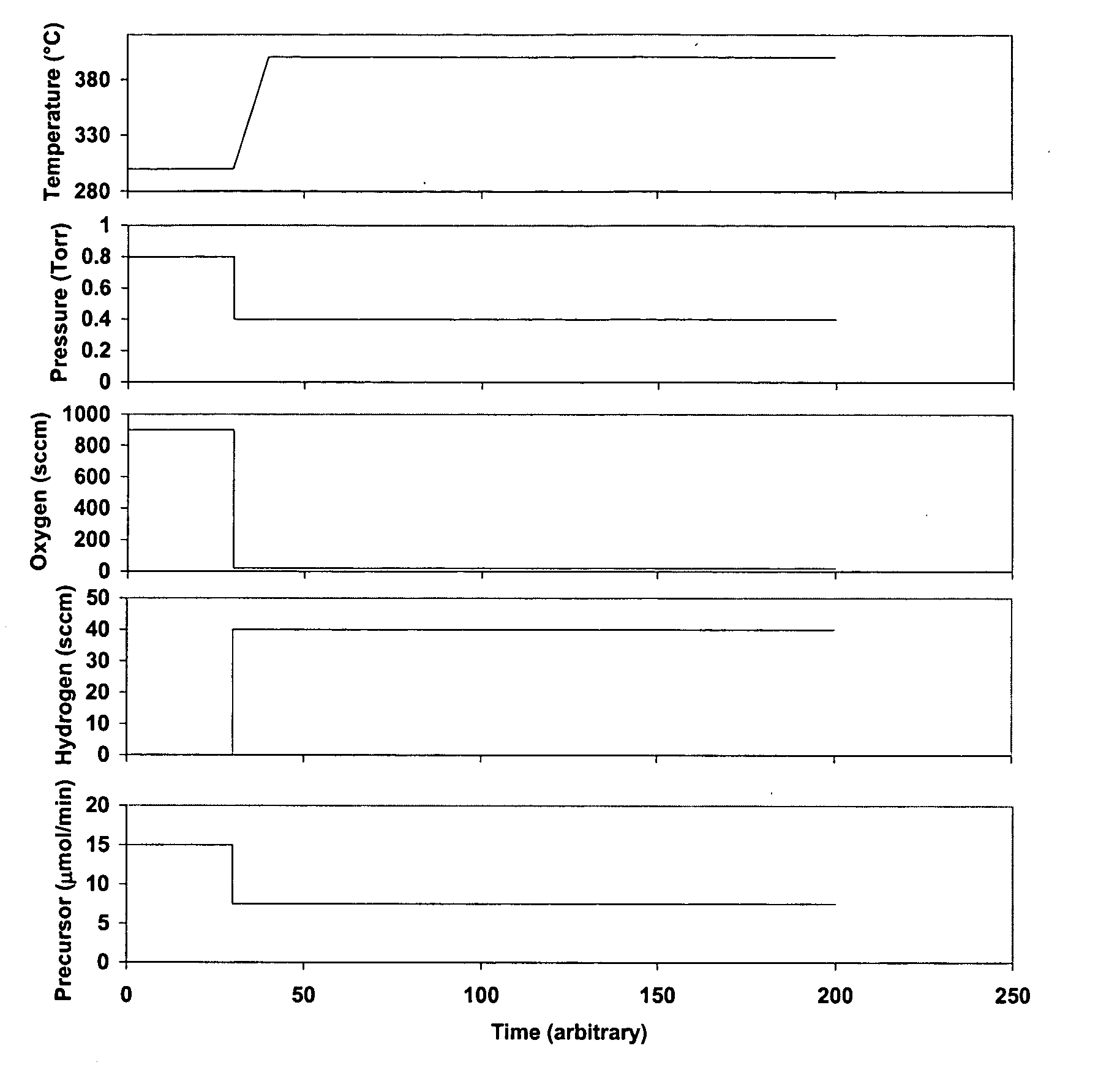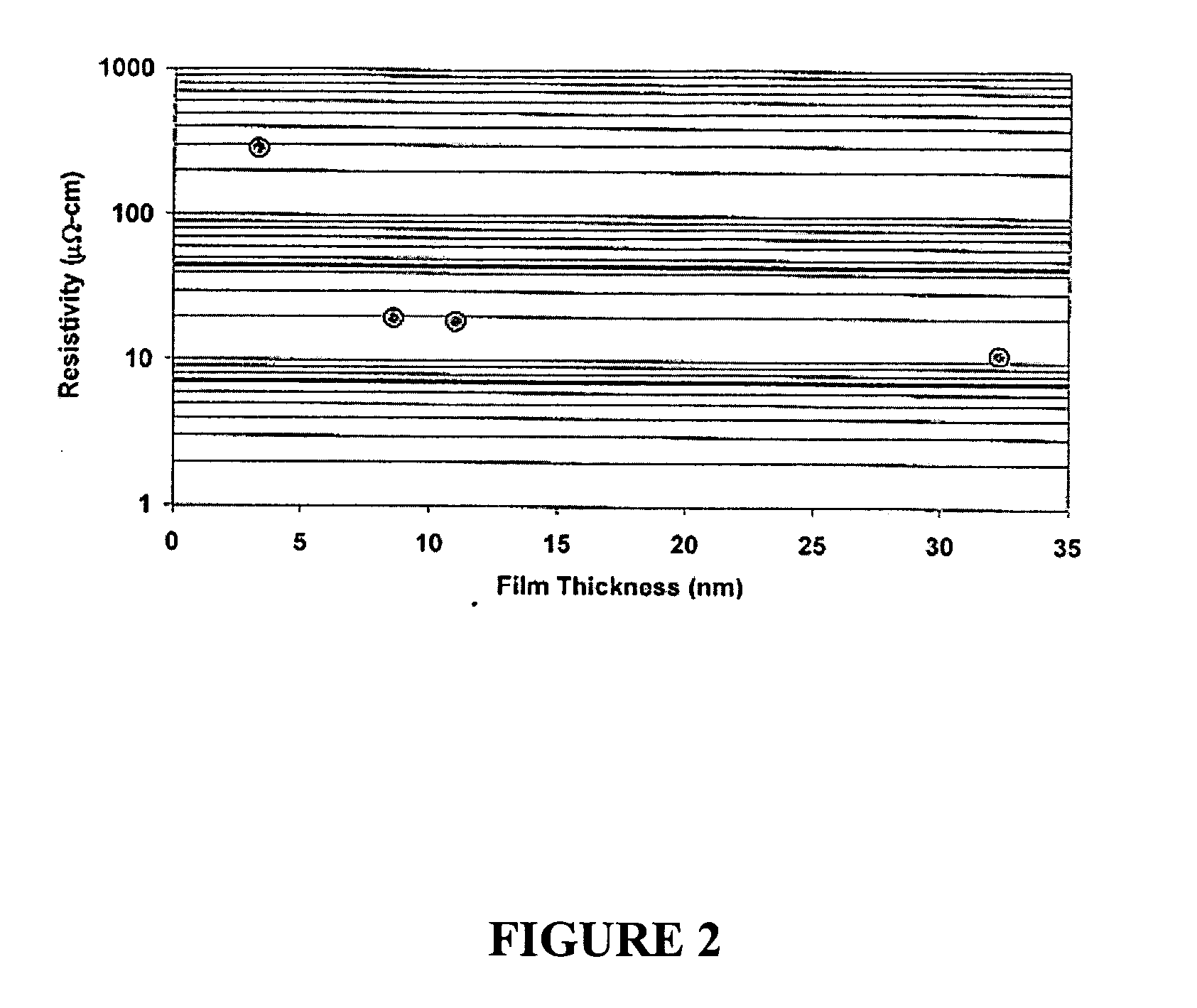Chemical vapor deposition of high conductivity, adherent thin films of ruthenium
a technology of adhesion and ruthenium, which is applied in the direction of liquid surface applicators, coatings, metal material coating processes, etc., can solve the problems of poor step limit, sputtering is limited by poor step, and the deposition of very thin ruthenium films (10 nm) is difficult and continuous, and cannot be used in mass production
- Summary
- Abstract
- Description
- Claims
- Application Information
AI Technical Summary
Problems solved by technology
Method used
Image
Examples
example 1
Comparison of Nucleation Layers Deposited Using Ru(EtCp)2 Precursor Relative to those Deposited Using Ru(thd)3 Precursor
[0070] An experiment was designed to compare Ru(EtCp)2 to Ru(thd)3 precursors over a wide range of process conditions to investigate the precursors relative utility when depositing very thin conductive films. The molar flow rate of the precursor was held constant at 15 μmol / min, the deposition time was held constant at 600 seconds and the total gas flow was held constant at 1000 sccm. Pressure, temperature, and reactive gas mixture were varied as shown in Table 1. The resulting film thicknesses (measured by XRF calibrated to RBS) and film resistivities (calculated using the physical thickness measured by spectroscopic ellipsometry) of the deposited films are also provided in Table 1. If film resistivity is not provided, it was too high to measure, indicating that the film was not continuous and / or contained substantial quantities of impurities. Of note, contrary t...
example 2
Process Conditions for the Deposition of the Nucleation Layer
[0072] The first deposition step of the CVD method taught herein results in the deposition of a ruthenium nucleation layer. Table 2 illustrates four different ruthenium nucleation layers deposited according to the method taught herein and the conditions and characteristics of each layer:
TABLE 2Process conditions for deposition of ruthenium nucleation layerReact-antDeposi-resis-Processgasestiontivity / numberT / ° C.p / Torr(wt %)rateDensityPhaseμΩ-cm14000.82% O2 / 2.741%metal∞4% H2Å / min23000.890% O23.029%oxide214Å / min33001.090% O23.050%metal138Å / min43000.82% O2 / 2.529%metal∞4% H2Å / min
[0073] In all cases, the ruthenium source gas was a vaporized solution of Ru(thd)3. It was initially thought that process numbers 1 and 4, using co-reactant gases having lower oxygen content, would result in a deposited ruthenium nucleation layer with less residual oxygen thereby providing a more conductive layer. However, the resistivity was too hi...
example 3
Process Conditions for Depositing the Upper Layer
[0074] The second deposition step of the CVD method results in the deposition of a ruthenium upper layer yielding the final ruthenium thin film, as taught herein in one aspect of the invention. Table 3 illustrates three different experiments and the results of each, wherein the ruthenium nucleation layer and upper layer were deposited according to the first and second set of process conditions, respectively:
TABLE 3Process conditions for deposition of ruthenium thin filmsProcessT1 / ° C.p1 / Torrgas1 (wt %)prec. rate1resistivity / AdhesionnumberT2 / ° C.p2 / Torrgas2 (wt %)prec. rate2DensityμΩ-cmtape53001.090% O215 μmol / min44%172fail3000.430% O215 μmol / min63000.890% O215 μmol / min80%14.5pass4000.42% O2 / 4% H215 μmol / min73000.890% O215 μmol / min78%11.2pass4000.42% O2 / 4% H27.5 μmol / min
[0075] Process 5 represented a ruthenium thin film having a nucleation layer grown according to conditions enumerated in process number 3 hereinabove. Although the ...
PUM
| Property | Measurement | Unit |
|---|---|---|
| Temperature | aaaaa | aaaaa |
| Temperature | aaaaa | aaaaa |
| Temperature | aaaaa | aaaaa |
Abstract
Description
Claims
Application Information
 Login to View More
Login to View More - R&D
- Intellectual Property
- Life Sciences
- Materials
- Tech Scout
- Unparalleled Data Quality
- Higher Quality Content
- 60% Fewer Hallucinations
Browse by: Latest US Patents, China's latest patents, Technical Efficacy Thesaurus, Application Domain, Technology Topic, Popular Technical Reports.
© 2025 PatSnap. All rights reserved.Legal|Privacy policy|Modern Slavery Act Transparency Statement|Sitemap|About US| Contact US: help@patsnap.com



